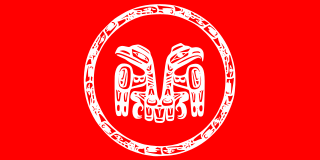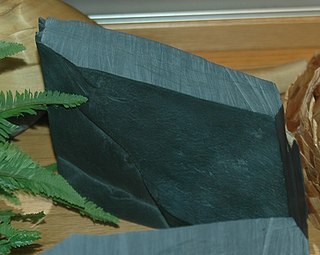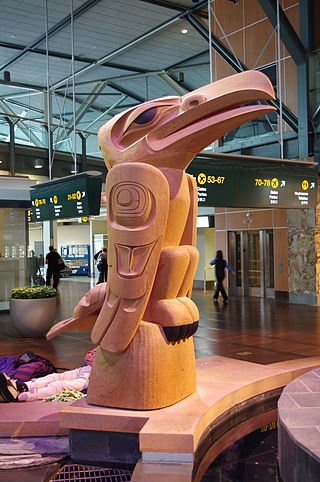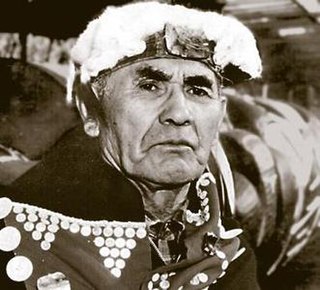External links
| | This article about a Canadian sculptor is a stub. You can help Wikipedia by expanding it. |
| | This biographical article about an Indigenous person of North America is a stub. You can help Wikipedia by expanding it. |
Reg Davidson (born 1954) is an Aboriginal Canadian carver and a member of the Haida band government.
He was born in 1954 at the Haida village of Masset on the Queen Charlotte Islands of British Columbia. His parents are Claude and Vivian Davidson and, through Claude, he is the grandson of the Haida artist and memoirist Florence Davidson. He is a member of the Eagle moiety, Ts'ał'lanas lineage. He began carving argillite in 1972 and became apprenticed to his older brother, the carver Robert Davidson, during the carving of a housefront and houseposts in honour of their grandmother Florence Davidson's father Charles Edenshaw in 1977 and 1978.
Davidson works in argillite and wood and also produces silkscreens.

William Ronald Reid Jr. was a Haida artist whose works include jewelry, sculpture, screen-printing, and paintings. Producing over one thousand original works during his fifty-year career, Reid is regarded as one of the most significant Northwest Coast artists of the late twentieth century.

The Haida are an Indigenous group who have traditionally occupied Haida Gwaii, an archipelago just off the coast of British Columbia, Canada, for at least 12,500 years.

Argillite is a fine-grained sedimentary rock composed predominantly of indurated clay particles. Argillaceous rocks are basically lithified muds and oozes. They contain variable amounts of silt-sized particles. The argillites grade into shale when the fissile layering typical of shale is developed. Another name for poorly lithified argillites is mudstone. These rocks, although variable in composition, are typically high in aluminium and silica with variable alkali and alkaline earth cations. The term pelitic or pelite is often applied to these sediments and rocks. Metamorphism of argillites produces slate, phyllite, and pelitic schist.
Robert Charles Davidson LL. D. D.F.A., is a Canadian artist of Haida heritage. Davidson's Haida name is G̲uud San Glans, which means "Eagle of the Dawn". He is a leading figure in the renaissance of Haida art and culture. He lives in White Rock, British Columbia.

Dempsey Bob, is a Northwest Coast woodcarver and sculptor from British Columbia, Canada, who is of Tahltan and Tlingit First Nations descent. He was born in the Tahltan village of Telegraph Creek on the Stikine River in northwestern B.C., and is of the Wolf clan.
Freda Diesing was a Haida woman of the Sadsugohilanes Clan, one of very few female carvers of Northwest Coast totem poles and a member of the Council of the Haida Nation of British Columbia, Canada. Her Haida name is Skil Kew Wat, meaning "magical little woman."

Florence Edenshaw Davidson (1896–1993) was a Canadian First Nations artist from Haida Gwaii. She created basketry and button blankets and was a respected elder in her village of Masset, Haida Gwaii, British Columbia.

Charles Edenshaw was a Haida artist from Haida Gwaii, British Columbia. He is known for his woodcarving, argillite carving, jewellery, and painting. His style was known for its originality and innovative narrative forms, created while adhering to the principles of formline art characteristic of Haida art. In 1902, the ethnographer and collector Charles F. Newcombe called Edenshaw “the best carver in wood and stone now living.”
Walter Harris, also known as Simogyet Geel, was a Canadian artist and hereditary chief from the Gitxsan (Gitksan) First Nation in northwestern British Columbia.

Northwest Coast art is the term commonly applied to a style of art created primarily by artists from Tlingit, Haida, Heiltsuk, Nuxalk, Tsimshian, Kwakwaka'wakw, Nuu-chah-nulth and other First Nations and Native American tribes of the Northwest Coast of North America, from pre-European-contact times up to the present.

Chief Mungo Martin or Nakapenkem, Datsa, was an important figure in Northwest Coast style art, specifically that of the Kwakwaka'wakw Aboriginal people who live in the area of British Columbia and Vancouver Island. He was a major contributor to Kwakwaka'wakw art, especially in the realm of wood sculpture and painting. He was also known as a singer and songwriter.
Margaret B. Blackman is an anthropologist known for her work with the Haida First Nation of Haida Gwaii in British Columbia, Canada, beginning in the 1970s.
Michael Nicoll Yahgulanaas is a visual artist, author, and public speaker. His work has been seen in public spaces, museums, galleries and private collections across globe. Institutional collections include the British Museum, Metropolitan Museum of Art, Seattle Art Museum, Vancouver Art Gallery, and the Humboldt Forum.

Haida argillite carvings are a sculptural tradition among the Haida indigenous nation of the Northwest Coast of North America. It first became a widespread art form in the early 19th century, and continues today.

Primrose Adams was a Canadian First Nations artist and member of the Raven Clan from the Haida nation. She wove hats and baskets in the Haida method and is most notable for her spruce root basketry, which involves working in the traditional manner of collecting and dyeing her own spruce root. Adams died in January 2020.
Doug Cranmer (1927–2006), also known as Pal'nakwala Wakas and Kesu', was a Kwakwaka'wakw carver and artist as well as a 'Namgis chief. Cranmer was a significant figure in the Northwest Coast art movement, both in its traditional form and in a modern contemporary form that he created and developed.

James Hart is a Canadian and Haida artist and a chief of the Haida Nation.
Dadens (daa.adans), also referred to as Tartenee and Tatense by some early European settlers and Tatense Reserve 16 under the Indian Act is village on the southern coast of Langara Island belonging to the Haida Nation on the archipelago Haida Gwaii, British Columbia, Canada. Dadens was once a popular trading post for the North Pacific fur trade among European traders in the late 18th century, due to its size and accessibility. Dadens no longer continues to be used by families year round, but it was used as a fishing village during the summer months by many Haida up until the 1950s and 1960s, and is still used to a limited extent today. There have been multiple migrations of families from Dadens to South East Alaska and these people are now known as the Kiagani Haida.
Kiusta located on Haida Gwaii is the oldest Northern Haida village: and the site of first recorded contact between the Haida and Europeans in 1774. Haida lived in this village for thousands of years, due to the sheltered nature of its location it was used for boats offloading, especially in rough waters. Kiusta is one of the oldest archeological sites of human use in British Columbia, and continues to be a site for cultural revitalisation.
Ulli Steltzer was a German photographer best known for her works photographing First Nations people and art in B.C., Canada, including Haida artist Bill Reid. Steltzer had numerous exhibits in and around Vancouver, and both Princeton University and the University of Victoria have collections of her works.